Excerpts from Jim Conrad's
Naturalist Newsletter
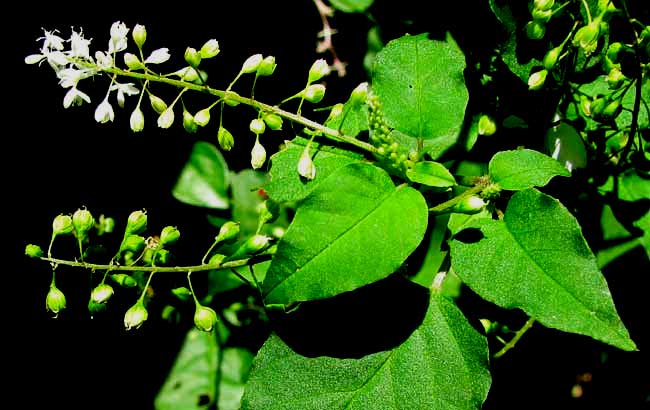
from the December 20, 2009 Newsletter issued from Hacienda Chichen Resort beside Chichén Itzá Ruins, central Yucatán, MÉXICO; limestone bedrock, elevation ~39m (~128ft), ~N20.676°, ~W88.569°
PIGEONBERRY
Along trails and at woods edges there's lots of the two- to six-ft-high, herbaceous-looking but woody- based plants bearing racemes of white flowers shown above.
If the plant looks like a diminutive pokeweed it's because usually it's assigned to the Pokeweed Family, the Phytolaccaceae, though some put it into the Petiveria Family, the Petiveriaceae, which I've never heard of. In English it's called Pigeonberry, Rouge-Plant, Baby Peppers and other names. It's RIVINA HUMILIS, and the reason it has English names is that it grows in the US Deep South, as well as the West Indies, and Mexico south into South America. It's a delicate-looking plant but clearly a tough one if it can prosper over such a large distribution.
The flowers, only about 1/8th inch long (4 mm), bear looking at. One with its four swoop-backed sepals, four stamens looking like matchsticks with crooked heads, and the ovary with its slender neck, or style, bent to one side before thrusting the pollen-receiving stigma beyond the clustered anthers is shown below.

One wonders why the flower feels the need to bend its style. All Pigeonberry flowers do it, and it seems to be a feature of the whole genus.
As racemes of Pokeweed flowers soon give way to dark purple fruits, Pigeonberry's flowers soon are replaced by glossy, bright red berries, as shown below:
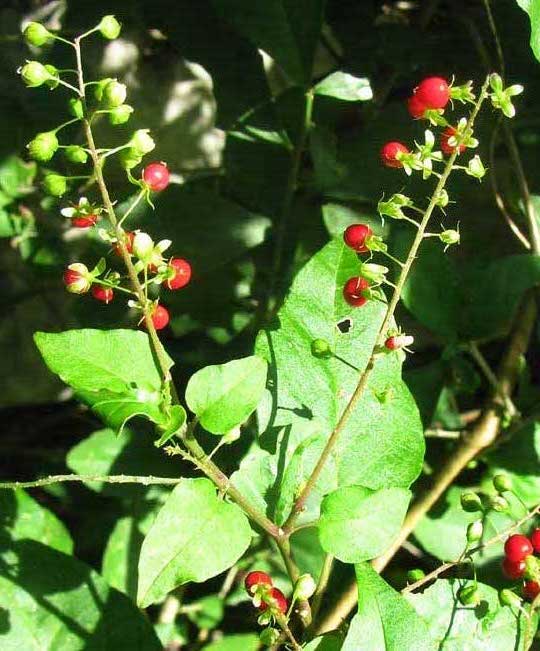
The berries, though very eye-catching with their gaudy redness as you walk along a trail, are small, only about 1/8th inch across (4 mm). Despite one of the plant's names being Baby Peppers, the fruits aren't spicy-hot at all. They taste slightly unpleasant, a little bitter and oily. Birds eat them but not as readily as you'd expect of a fruit so perfectly sized for bird-nibbling and so visible. You see some racemes holding ripe, red fruits for days with no one eating them. Maybe this is explained by a website referring to Pigeonberry as a toxic plant that causes milk taint if cows eat it.
Also I read that juice from the berries once was used as a dye and ink, and that the fruits contain a pigment known as Rivianin or Rivinianin, which is very similar to betanin, the pigment found in beets.
In tropical and subtropical areas Pigeonberry makes a fine groundcover in places too shaded for other plants. In deep shade it simply grows smaller than where it has plenty of sunlight, but it still produces pretty racemes of white flowers followed by crimson berries of questionable edibility.
from the September 28, 2018 Newsletter issued from Rancho Regenesis in the woods ±4kms west of Ek Balam Ruins; elevation ~40m (~130 ft), N~20.876°, W~88.170°, central Yucatán, MÉXICO
ANOTHER FACE OF PIGEONBERRY
After making the above observations, I'd grown accustomed to thinking of Pigeonberries as soft herbs with woody bases, usually about knee high but rarely growing head-high. This week along a cow trail through the woods I found what looked exactly like the normal Pigeonberry, but it was different. A flowering sprig of the fence plant is shown below:
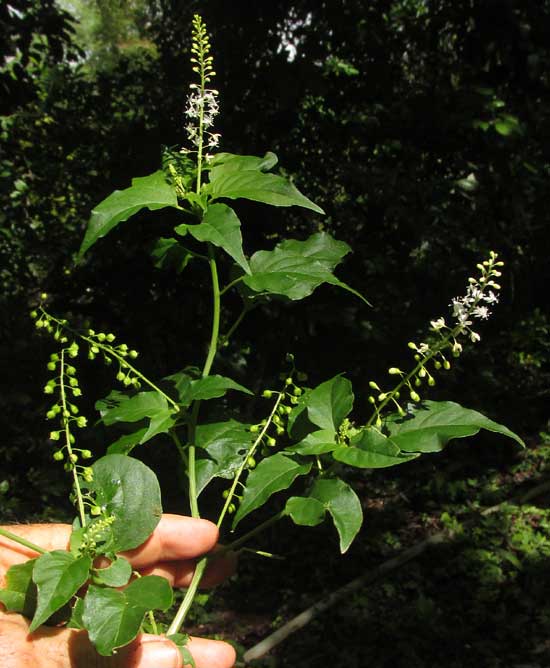
What was different about it was that the above sprout, instead of being part of a low herb, grew from a woody-based vine entangling ten or so feet of dilapidated fence, as shown below:
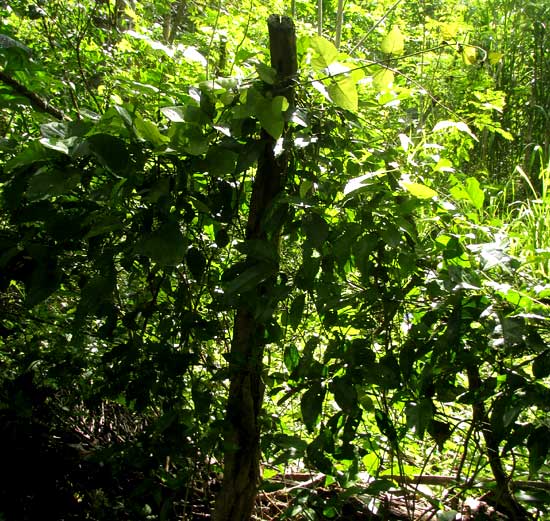
Also, I remembered the flowers as having stamens whose filaments bent over the ovary, crisscrossing one another, as shown on our Pigeonberry page. The fence-plant's stamens spread widely, not crisscrossing at all, as seen below:
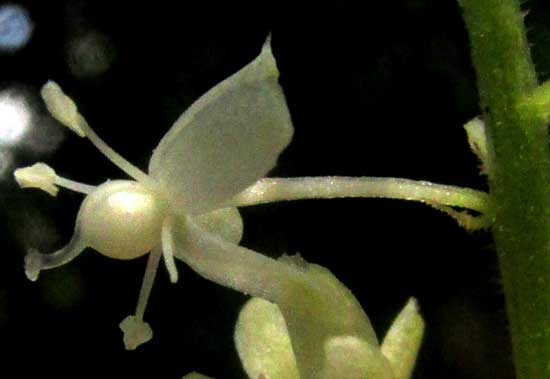
The red fruits were the same, though, shown below:
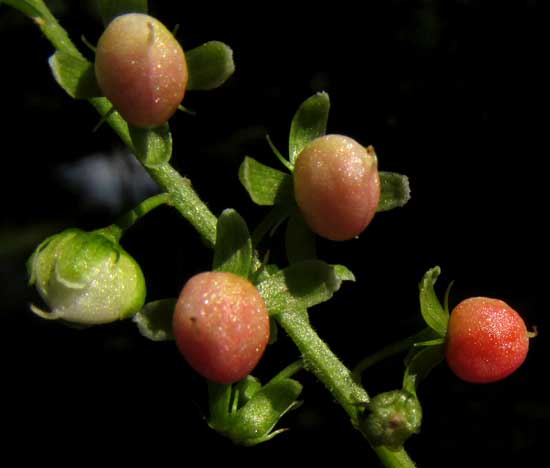
Surely this was a second species of Pigeonberry, a second species of the genus Rivina. However, no second species was listed for the Yucatan.
It turns out that Pigeonberry can display forms ranging from small herbs to large, woody-based, much-branched vines, and it's all the same thing. A drawing in my old Bailey's Manual of Cultivated Plants also shows stamens crisscrossing over the ovary, and says that the plants only reach 3ft high (1m). Apparently Bailey didn't know how the plant behaves in the tropics, and his drawing was of a newly opened flower, like my earlier pictures. More mature blossoms have widely spreading stamens.
So, as with humans, it's easy to gain false first impressions of plants, so it's worth continuing to pay attention to details, even when you think you know all you need to.
entry dated September 13, 2022, issued from near Tequisquiapan, elevation about 1,900m (6200 ft), Querétaro state, MÉXICO
PIGEONBERRY IN UPLAND CENTRAL MEXICO
Here's yet another appearance of a Pigeonberry flower, this time in upland central Mexico, on a plant that otherwise looked and behaved like those in the Yucatan:
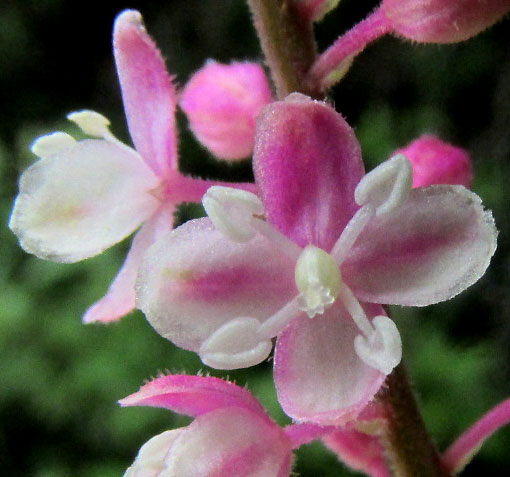
The Flora of North America describes the genus Rivina as embracing only this species.